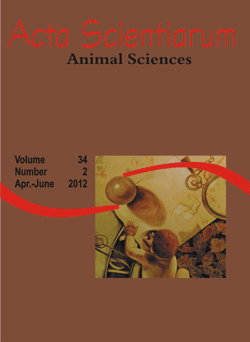<b>Interaction between feeding rate and area for periphyton in culture of Nile tilapia juveniles</b> - doi: 10.4025/actascianimsci.v34i2.12469
Resumo
The objective of the present work was to determine the effects of the interaction between feeding rate and area for periphyton in rearing aquaria for Nile tilapia. Twenty 25 L polyethylene outdoor aquaria were used to hold experimental fish. Three tilapia fingerlings (2.56 ± 0.14 g) were stocked in each aquarium for five weeks (12 fish m-2). There were two different feeding rates (full and full minus 30%) and two submerged areas for periphyton development (59.4% and 96.5% of the aquarium surface area; n = 5). Final body weight, specific growth rate and yield in the 96.5%-area aquaria of fish submitted to 30% less feed were significantly higher than in the 96.5%-area aquaria submitted to full feeding rates. Fish growth in the restricted-feed aquaria was favored by their better water quality (higher pH and lower total ammonia nitrogen). There were negative effects on final body weight, SGR, yield and feed conversion ratio of fish in full-feed aquaria when the area for periphyton increased from 59.4 to 96.5%. It was concluded that the combination of restricted feeding rates with large substrate areas for periphyton growth results in better water quality for fish culture than the adoption of each management alone.
Downloads
DECLARAÇÃO DE ORIGINALIDADE E DIREITOS AUTORAIS
Declaro que o presente artigo é original, não tendo sido submetido à publicação em qualquer outro periódico nacional ou internacional, quer seja em parte ou em sua totalidade.
Os direitos autorais pertencem exclusivamente aos autores. Os direitos de licenciamento utilizados pelo periódico é a licença Creative Commons Attribution 4.0 (CC BY 4.0): são permitidos o compartilhamento (cópia e distribuição do material em qualqer meio ou formato) e adaptação (remix, transformação e criação de material a partir do conteúdo assim licenciado para quaisquer fins, inclusive comerciais.
Recomenda-se a leitura desse link para maiores informações sobre o tema: fornecimento de créditos e referências de forma correta, entre outros detalhes cruciais para uso adequado do material licenciado.
































